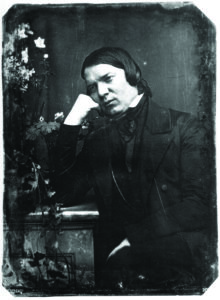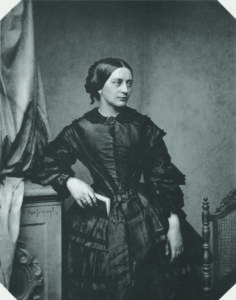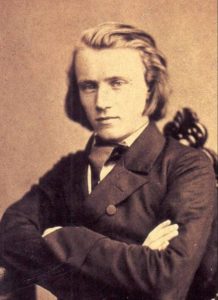
The Houston Symphony’s signature event of the 2019–20 season, Schumann Festival: Angels and Demons celebrates German composer Robert Schumann (1810–1856). As a music critic, he championed the work of a young Johannes Brahms, whose Violin Concerto is also a part of the Symphony’s Classical series on December 5, 7 & 8. Before Robert’s untimely death, Brahms became a close friend to Robert and Clara Schumann—and perhaps more.
On February 27, 1854, Robert Schumann attempted suicide by jumping from a bridge into the river Rhine. Some fishermen soon rescued him, but his sanity was gone. For years he had struggled with mental illness: he heard voices; the note “A” droned on in his head for hours; strange music played in his mind; visions of angels turned into hellish nightmares. When he emerged from the river, he was taken by his own request to an asylum, where he would spend the remaining two years of his life. Despite lucid periods, the great composer would never recover.

As soon as news of the catastrophe reached him, Johannes Brahms raced to Düsseldorf to assist Robert’s wife Clara, who was also a composer and accomplished pianist. Clara was pregnant with her seventh child. Brahms had arrived at the Schumanns’ home five months before as a young, unknown, aspiring composer. After hearing Brahms play some of his own music, Robert and Clara had instantly recognized him as a genius. They welcomed him into their household, and Robert declared Brahms the true heir of Beethoven in a widely read musical publication, making him famous overnight.
For Johannes, the Schumanns were generous mentors and friends, and he was eager to help them in their time of need. He took up lodgings in Düsseldorf and began to help Clara sort through Robert’s affairs and look after her children as she prepared for childbirth and the resumption of her career as one of Europe’s leading pianists.
As Johannes and Clara spent more time together, their feelings for each other deepened into something beyond friendship. Brahms wrote to a friend, “I believe that I do not have more concern for and admiration for her than I love her and find love in her. I often have to restrain myself forcibly from just quietly putting my arms around her and even—: I don’t know, it seems to me so natural that she could not misunderstand.”

Clara confided to her diary, “There is the most complete accord between us… It is not his youth that attracts me: not, perhaps, my flattered vanity. No, it is the fresh mind, the gloriously gifted nature, the noble heart, that I love in him.”
Such feelings were unspeakable and treacherous so long as Robert remained alive. After Robert’s death, Clara and Johannes went to Switzerland accompanied by family. No one will ever know all that passed between them, but after the sojourn in Switzerland, the two parted ways. Brahms never married, and Clara would never remarry; they would remain steadfast friends for the rest of their lives. —Calvin Dotsey
Join the Houston Symphony for the Schumann Festival, featuring concerts at Jones Hall and more across the city, in February 2020. See the schedule and get tickets. For a quick look at Robert Schumann’s biography, read on!



